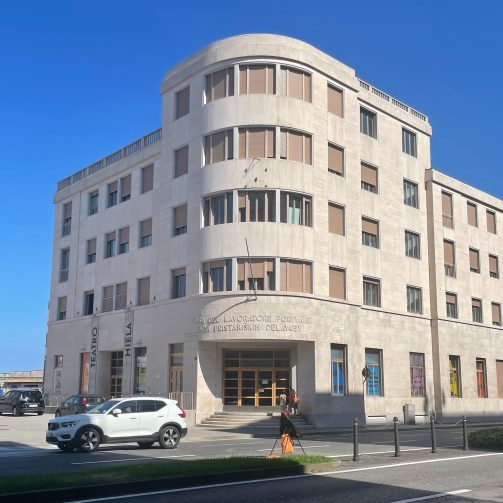The Port Worker’s House was built between 1938 and 1942 on the area where the old fish market stood, demolished to create the square that was given the name Piazza Luigi Amedeo duca degli Abruzzi in 1933.
The intention was to construct a building to be used for administrative and after-work offices: it was the Royal Port Labor Office that ordered its construction in the 1930s, together with the Fascist Union of Port Workers and the Lino Domeneghini, Odoardo Huetter, Tommaso Gulli and Ettore Saletnig Port Companies, which later became its owners. The project was entrusted to civil engineer Giuseppe Zaccaria, then an official at the Public General Warehouses of Trieste, today’s Port Authority. The basic idea was to build a connecting element to the rail customs warehouse in a strategic area of the Old Port, a crossroads of rail, sea and road traffic.
The foundation stone-laying ceremony took place in the presence of Benito Mussolini on September 18, 1938, with the project still to be approved by the Municipal Building Commission.
The building, completed in 1942, whose façade runs between Duca degli Abruzzi Square and Corso Cavour forming a curve, is constructed of reinforced concrete and brick and consists of a ground floor of greater height than the other floors and three other floors above ground, to which a fourth floor is added at the central junction.
The “Fascist House of the Port Worker” represents a significant example of rationalist architecture, among the most interesting achievements of the Fascist era and the first half of the twentieth century in Trieste, along with the buildings on Via del Teatro Romano and those in the so-called Oberdan quarter, and is part of the urban redevelopment project of the Rive. On the façade we find the bilingual marble inscription “Port Worker’s House – Dom pristaniških delavcev”: the “Fascist” inscription had already been erased after World War II, when the Slovenian translation was added.
Today the building is the headquarters of the Casa del Cinema Association of Trieste, and on the ground floor is the Miela Theater, dedicated to the Trieste artist Miela Reina.









